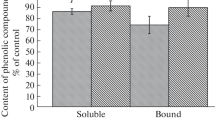Abstract
7 days or 7 weeks old alfalfa plants (Medicago sativa L.), susceptible (S) and resistant (R) to bacterial wilt, were inoculated withCorynebacterium michiganense pv.insidiosum and on day 8 and 15 after inoculation the levels of acid-soluble phosphate esters (P-esters) were determinated by means of32P labelling in the shoots or roots. The most significant changes were recorded in the roots of the older R plants grown in full Knop nutrient solutions on day 8 after inoculation. The marked reduction of inorganic phosphate (P1) uptake by whole R plants is accompanied by a decrease in the levels of fructose-l, 6-bisphosphate (Fru-P2), glucose-6-phosphate (Glc-6-P), fructose-6-phosphate (Fru-6-P), adenosine mono-, and diphosphate (AMP and ADP), phosphorylcholine (P-choline) and a proportional increase in the level of P1. In the S plants, infection affected neither P1 uptake nor P1 proportions. In the plants grown after inoculation in diluted Knop’s solutions (0.147 mM KH2PO4), infection induced a reduction of the radial transport of P1 to the segments of R roots whereas a reduction of the levels was only recorded in some P-esters [AMP, ADP, dihydroxyacetone phosphate (DHAP), and P-choline, but no decrease of Fru-P2, Glc-6-P and Fru-6-P]. In the S plants, P1 transport and the levels of P-esters were increased by the infection. P1 transport exhibited considerable metabolic dependence (DNP, DCCD). Bacterial infection probably had no influence on the activity of the plasma membrane ATPases.
Similar content being viewed by others
Abbreviations
- AMP, ADP, ATP:
-
adenosine mono-, di-, or triphosphate
- IJCCD:
-
N, N′-dicyclohexylcarbodiimide
- DHAP:
-
dihydroxyacetone phosphate
- DNP:
-
2,4-dinitro- phenol
- Fru-P2 :
-
fructose-1,6-bisphosphate
- Fru-6-P2 :
-
fructose-6-phosphate
- Glc-6-P:
-
glucose-6-phosphate
- P1 :
-
inorganic orthophosphate
- P-choline:
-
phosphoryicholine
References
Anderson, W. P.: Transport through roots. - In: Lüttge, U., Pitman, M. G. (ed.): Transport in Plants. II. Part B. Tissues and Organs. Encyclopedia of Plant Physiology, New Series, Vol. 2B. Pp. 129–156. Springer-Verlag, Berlin 1976.
Attia, A. F., Jeanjean, R.: Influence of osmotic shock and of plasmolysis on phosphate uptake by excised corn roots. -Physiol. vég.21: 39–47, 1983.
Bieleski, R. L.: Accumulation of phosphate, sulphate and sucrose by excised phloem tissues. - Plant Physiol.41: 447–454, 1966.
Bowling, D. J. F.: A relationship between phosphate uptake and membrane electrical potential in excised roots ofHelianthus annuus. - J. exp. Bot.34: 771–777, 1983.
Chapin, F. S., III, Bieleski, R. L.: Mild phosphorus stress in barley and a related low-phosphorus- adapted barley grass: Phosphorus fractions and phosphate absorption in relation to growth. - Physiol. Plant.54: 309–317, 1982.
Hanker, I., KůdelovÁ, A.: Changes in growth and in uptake, distribution and translocation of phosphorus in susceptible and resistant alfalfa plants induced bvCorynebacterium insidiosum. - Biol. Plant.21: 136–143, 1979.
Hanker, I., KůdelovÁ, A.: The uptake, distribution, leakage, and incorporation of32P into organic compounds in alfalfa plants susceptible and resistant to the bacterial wilt and the effect ofCorynebacterium insidiosum upon these processes. -Biol. Plant.25: 279–287, 1983.
Hanker, I., KůdelovÁ, A.: Characterization of phosphate esters in the shoots and roots of alfalfa plants susceptible and resistant to bacterial wilt. - Biol. Plant.28: 288–296, 1986.
Leonard, R. T., Hanson, J. B.: Induction and development of increased ion absorption in corn root tissue. - Plant Physiol.49: 430–435, 1972.
Lin, W.: Corn root protoplasts. Isolation and general characterization of ion transport. - Plant Physiol.66: 550–554, 1980.
Machácková, I., KrÁl, J., Zmrhal, Z.: Characterization of phosphate absorption in maize root cortex segments. - Biol. Plant.25: 366–372, 1983.
Migliaccio, F., Maas, E. V., Ogata, G.: Phosphate absorption, fluxes, and symplasmic transport in osmotically-shockedZea mays roots. - J. exp. Bot.35: 8–17, 1984.
Pitman, M. G.: Ion transport into the xylem. - Annu. Rev. Plant Physiol.28: 71–88, 1977.
Serrano, R.: Effect of ATPase inhibitors on the proton pump of respiratory-deficient yeast. - Eur. J. Biochem.105: 419–424, 1980.
van Steveninck, R. F. M.: The “washing ” or “ageing” phenomenon in plant tissues. - Annu. Rev. Plant Physiol.26: 237–258, 1975.
Author information
Authors and Affiliations
Rights and permissions
About this article
Cite this article
Hanker, I., Kůdelová, A. The bacterial wilt, uptake of phosphate, and phosphate ester levels in the resistant and susceptible alfalfa plants. Biol Plant 30, 63–73 (1988). https://doi.org/10.1007/BF02876428
Received:
Accepted:
Issue Date:
DOI: https://doi.org/10.1007/BF02876428



